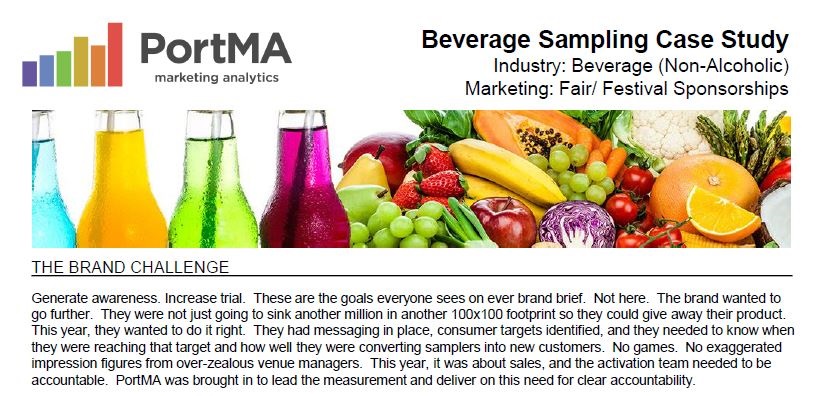An Experiential Marketing Case Study
The Brand Challenge
Generate awareness. Increase trial. These are the goals everyone sees on ever brand brief. Not here. The brand wanted to go further. They were not just going to sink another million in another 100×100 footprint so they could give away their product. This year, they wanted to do it right. They had messaging in place, consumer targets identified, and they needed to know when they were reaching that target and how well they were converting samplers into new customers. No games. No exaggerated impression figures from over-zealous venue managers. This year, it was about sales, and the activation team needed to be accountable. PortMA was brought in to lead the measurement and deliver on this need for clear accountability.
The Campaign
The campaign would visit large events frequented by their target consumer and use a unique engagement experience to communicate two key brand value messages. Through the integration of technology and a well-staffed footprint, the team engages every consumer with these value propositions as they walked them through a full serving sample experience.
The Measurement Strategy
Due to scheduling and timing, the measurement strategy focused on just five, multi-day events covering over 63,000 consumer engagements. The measurement focused on three points of data collection, all developed and managed by the PortMA team:
Event Recaps
After each day of activation, the manager onsite submitted information on a key set of activation metrics. Data was reviewed for accuracy and reliability after each event.
Consumer Exit Survey
As they completed their footprint experience, a cross-section of consumers were invited to complete a brief survey (average length 42 seconds). Data collection was seamlessly integrated into the run-of-show and resulted in over 1,700 completed interviews.
Post-Event Survey
Two weeks after their footprint experience, a cross-section of event patrons was sent an email invitation to complete an online survey. The survey asked about their recollection of the event experience, their understanding of the brand value proposition, and their actual purchase behavior. Just under 200 post-event surveys were completed.
The Results
Enthusiasm for the brand was strong onsite with three-fourths (78%) of those engaged, reporting that they would purchase the brand in the next two weeks. Post-event survey and sales analysis revealed that 58% actually did. And it wasn’t just existing buyers as over two-fifths (41%) of non-customers report buying the brand in the 10 to 14 days following their event experience.
All messaging wasn’t equal. A strong recall for “Message A” was associated with statistically significant higher post-purchase behavior than when the same or stronger levels of recall were expressed for “Message B.” This information was used to re-prioritize messaging and assure strong communication for those values which were maximizing actual sales.
It was estimated that the activations were converting non-customers to the brand at a rate of 11.2 new customers per staffing hour of activation. Some venues delivered much more than this (as high as 25.5 per hour) while others were much lower. Using this breakout, the brand team was able to better evaluate next year’s routing schedule and direct resources toward those sponsorships they now knew were delivering the greatest number of new customers.

